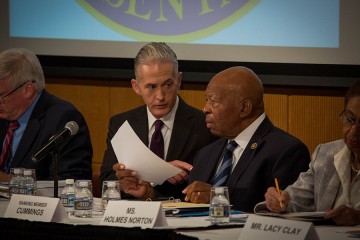- Name
- Barbara Benham
- bbenham1@jhu.edu
- Name
- Robin Scullin
- rsculli@jhu.edu
Health care insurers including Medicare, Medicaid, and major private insurers haven't done enough to combat the opioid epidemic, a study led by researchers at the Johns Hopkins Bloomberg School of Public Health suggests.
The researchers examined major insurers' 2017 coverage policies for drugs to treat chronic lower-back pain. They concluded that these policies missed important opportunities to steer patients toward safer and more effective treatments than prescription opioids.
"Our findings suggest that both public and private insurers, at least unwittingly, have contributed importantly to the epidemic," says study senior author G. Caleb Alexander, an associate professor in the Bloomberg School's Department of Epidemiology and co-director of the Johns Hopkins Center for Drug Safety and Effectiveness.
The study, published online today in the journal JAMA Network Open, offers one of the most comprehensive looks ever at insurers' pain coverage policies and comes as the opioid epidemic continues to ravage communities across the country. The U.S. Department of Health and Human Services has estimated that in 2016—the most recent year for which complete data are available—more than 42,249 Americans died from opioid overdoses, the most of any year on record. More than 2.1 million Americans had an opioid use disorder or addiction in 2016, with economic costs from the epidemic estimated to be as high as $504 billion.
Alexander and colleagues, with funding and technical assistance from the Office of the Assistant Secretary for Planning and Evaluation at DHHS, the National Institutes of Health, and the Centers for Disease Control and Prevention, analyzed the coverage policies of 15 Medicaid plans, 15 Medicare Advantage plans, and 20 commercial insurers in 2017. The team focused on common plan types within 16 states that together are home to about one-half of the U.S. population. Many of the states examined have been hit especially hard by the epidemic. The researchers also conducted in-depth interviews with more than 40 senior health care executives who administered representative plans.
The investigators focused on 62 prescription drugs used to treat chronic lower-back pain, one of the most common types of chronic, noncancer pain for which prescription opioids have been overused. Their analysis included 30 prescription opioids and 32 other drugs, including nonsteroidal anti-inflammatory drugs, or NSAIDs; muscle relaxants; and topical analgesics.
The analysis revealed that many insurers failed to apply evidence-based "utilization management" rules—limiting quantities of opioids prescribed, starting treatment with less risky drugs such as NSAIDs, and/or requiring prescribers to get prior approval from insurers—to discourage opioid overuse and encourage safer and more effective alternatives. What's more, many of the utilization management rules in place were applied as often to non-opioids as opioids.
"Opioids are just one tool in the pain management tool box, and unfortunately, many of the plans that we examined didn't have well-developed policies in place to limit their overuse," Alexander says.
The researchers also found that both public and commercial plans tended to make covered opioids available relatively inexpensively. The median commercial plan, for example, placed 74 percent of opioid painkillers in Tier 1, the lowest cost category. The median commercial co-pay for Tier 1 opioids was just $10 for a month's supply.
"To their credit, while every health plan we examined was actively trying to combat the epidemic, their focus was generally on utilization management and identifying high-volume prescribers and patients, rather than on comprehensive strategies to improve the treatment of chronic pain," Alexander says. On the whole, these coverage policies "help explain why the opioid epidemic has taken root," he adds.
In 2016, the CDC issued recommendations for stricter limits on opioid prescribing, noting among other things that "nonopioid therapy is preferred for chronic pain outside of active cancer, palliative, and end-of-life care." These guidelines, as well as soaring rates of injuries and deaths from opioids, continue to shape changes in clinical practice.
"Insurers can either be part of the problem, or part of the solution," Alexander says. "The good news is that an increasing number of health plans are recognizing their contribution to the epidemic and developing new policies to address it. The bad news is that we have a very long way to go."
Posted in Health
Tagged prescription drugs, opioids












